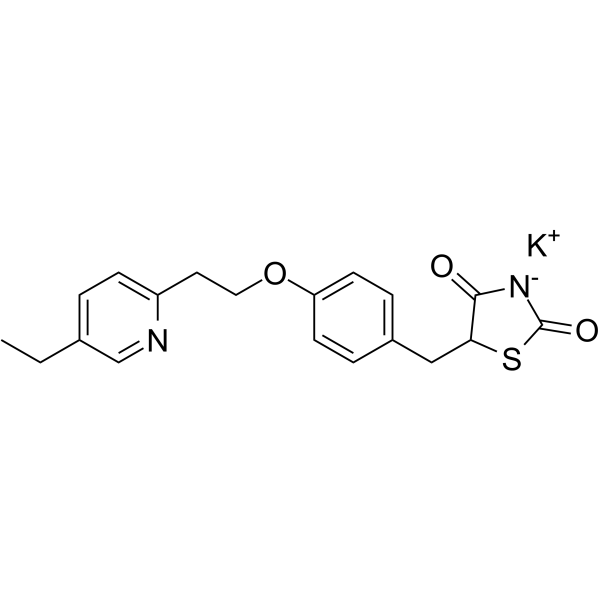1266523-09-4
| Name | Potassium 5-{4-[2-(5-ethyl-2-pyridinyl)ethoxy]benzyl}-2,4-dioxo-1,3-thiazolidin-3-ide |
|---|---|
| Synonyms |
Potassium 5-{4-[2-(5-ethyl-2-pyridinyl)ethoxy]benzyl}-2,4-dioxo-1,3-thiazolidin-3-ide
2,4-Thiazolidinedione, 5-[[4-[2-(5-ethyl-2-pyridinyl)ethoxy]phenyl]methyl]-, potassium salt (1:1) |
| Description | Pioglitazone (U 72107) potassium is an orally active and selective PPARγ (peroxisome proliferator-activated receptor) agonist with high affinity binding to the PPARγ ligand-binding domain with EC50 of 0.93 μM and 0.99 μM for human and mouse PPARγ, respectively. Pioglitazone potassium can be used in diabetes research[2][3][4]. |
|---|---|
| Related Catalog | |
| Target |
mouse PPARγ:0.99 μM (EC50) h-PPARγ:0.93 μM (EC50) hPPARδ:43 μM (EC50) hPPARα:100 μM (EC50) mouse PPARα:100 μM (EC50) |
| In Vitro | Pioglitazone potassium (0.5 or 1 μM, 5 days) can completely prevent AGEs (advanced glycation end-products)-induced β-cell necrosis and the increase of caspase-3 thereby avoiding the impaired viability caused by AGEs in pancreatic beta cell line HIT-T15[2]. Pioglitazone potassium (1 μM, 1 h) can stimulate insulin secretion induced by low glucose concentration and attenuate the GSSG/GSH ratio in cells cultured with AGEs[2]. |
| In Vivo | Pioglitazone potassium (oral gavage, 10 or 30 mg/kg, once daily, 14 days) can induce improvements in insulin resistance and diabetes that may be lipocalin-dependent in the liver but not in skeletal muscle[3]. Pioglitazone potassium (oral gavage, 10 mg/kg, once daily, 4 weeks) can significantly reduce body weight (BW), cardiac hypertrophy, elevated blood glucose levels and improve the associated dyslipidemia[4]. Animal Model: ob/ob and adipo-/- ob/ob mice with a C57Bl/6 background[3] Dosage: 10 or 30 mg/kg Administration: Oral gavage; once daily; 14 days Result: Showed no changes of serum-free fatty acid and triglyceride levels as well as adipocyte sizes in ob/ob and adipo-/- ob/ob C57BL/6 mice at 10 mg/kg but significantly reduced to a similar degree at 30 mg/kg. Also showed no changes of expressions of TNFα and resistin in adipose tissues of ob/ob and adipo-/- ob/ob mice at 10 mg/kg but decreased at 30 mg/kg. Animal Model: Male Wistar albino rats[4] Dosage: 10 mg/kg Administration: Oral gavage; once daily; 4 weeks Result: Decreased the elevated serum levels of both creatinine and creatine kinase-MB (CK-MB), TGF-β1 gene expression and regulated the expression of MMP-2/TIMP-2 system. |
| References |
| Molecular Formula | C19H19KN2O3S |
|---|---|
| Molecular Weight | 394.529 |
| Exact Mass | 394.075348 |
